
The Republican Party is in the weakest position it has been in two decades of Pew Research Center polling. Interviews with more than 7,000 respondents nationwide so far this year found just 23% identifying themselves as Republicans. This is down from 25% in 2008 and 30% as recently as 2004. In total, the GOP has lost roughly a quarter of its base over the past five years.
But these Republican losses have not translated into clear Democratic gains. So far in 2009, 35% of adults nationwide identify as Democrats, about the same as in 2008 (36%). While GOP identification has fallen seven points since 2004, the Democrats have only gained two points over that period. Instead, a growing number of Americans describe themselves as independents, 36% in 2009 compared with just 32% in 2008 and 30% in 2004.
Democrats do hold a clear edge among independent voters. The share of Americans who shun a major party label but say that they currently “lean” toward the Democratic Party has risen from 13% in 2004 to 17% today. Meanwhile, the share leaning toward the GOP has remained relatively flat. When these leaners are combined with partisans, the Democrats hold an overwhelming 53% to 36% edge over the Republicans.
70 Years of Party Identification
While these changes are substantial and significant, a broader historical perspective shows that they are not unprecedented. A comprehensive aggregation of nationwide Gallup Organization surveys conducted between 1939 and 1989 shows not only that the current partisan gap is far from the largest on record, but also that the country has experienced rapid changes in the balance of party identification prior to the current era.
For example, while the GOP has lost seven points in party identification in just the last five years, the Democrats lost fully nine points in the two-year period from 1983 to 1985 around Ronald Reagan’s reelection. The Democrats also lost nine points in identification between 1964 and 1967, from a peak of 51% in the year after John F. Kennedy’s assassination to 42% in 1967 after the passage of the Civil Rights and Voting Rights acts shattered the Democratic Party’s dominance in the South.
The Republican Party has also experienced declines in party identification in the past that rival the current period. Between 1944 and 1949 GOP identification fell six points from 38% to 32%, and it fell six points from 27% in 1970 to 21% in 1975 following the Watergate scandal and Richard Nixon’s resignation.


While the current period of change is not unprecedented, the GOP figures are nearing historic lows. With only 23% of Americans identifying as Republicans in the first four months of 2009, this is the lowest figure since the all-time low of 21% for the party reached in 1975, 1977 and 1979.
One of the factors that distinguishes the current period of partisan transition from others is that the GOP losses are not translating into Democratic gains. By contrast, in the short period from 1983 to 1985 the nine-point decline in Democratic identification was matched by an eight-point Republican gain. Combined, this short period represents by far the most substantial reshaping of the partisan landscape, as a 19-point Democratic edge shrank to just two points.
Similarly, between 1956 and 1961 the Democratic Party gained eight points, nearly matched by a five-point drop in Republican identification. As a result, a 10-point edge for the Democrats at the start of this period grew to a 23-point edge in Kennedy’s first year in office.
The closest historical parallel to the current pattern of one party losing ground while the other made only limited gains was during the Johnson administration. In just the three years between 1964 and 1967, Democratic Party identification fell nine points, but the GOP gained only two points.
The other striking factor in the long term trend in party identification is the record number of political independents in 2009 – 36% of Americans describe themselves this way. The only previous year in which independent identification was this high was in 1992 when Ross Perot ran a widely popular independent party candidacy. The number of independents had dropped as low as 29% as recently as 2001.
The Bush Legacy in Perspective

While there is no doubt that the Republican Party’s public appeal suffered between George W. Bush’s first year in office and his last, the magnitude of the change is well below that experienced by two of his presidential predecessors – Lyndon Johnson and Ronald Reagan. From his first year in office to his last, Johnson saw the share of Americans identifying as Democrats plummet. A two-to-one Democratic advantage in 1964 (51% vs. 25% Republican) was cut nearly in half by 1968. Reagan’s tenure was nearly as bad for the Democratic Party, as a 14-point Democratic edge in his first year faded to just five by his last. And this probably understates Reagan’s overall legacy, as GOP identification had already spiked four points (and Democratic identification fallen four points) between 1980 and 1981.
But the changes in party affiliation between George W. Bush’s first and last year were not insubstantial. A four-point decline in GOP identification and two-point Democratic gain left a fundamentally different landscape during the 2008 election to decide his successor. By this measure, the Bush years were comparable to the Nixon years, when the GOP lost four points in identification between 1969 and 1974 and the Democrats gained three.
A Shift in Affiliation, but Not Ideology
The recent losses suffered by the Republican Party do not appear to be the result of a fundamental ideological break from the past. In more than 7,000 interviews conducted in the first four months of 2009, 37% of Americans describe themselves as politically conservative – roughly double the number who say they are liberal (19%). This ratio has remained largely stable over the past nine years, even while the balance of party affiliation has changed substantially.
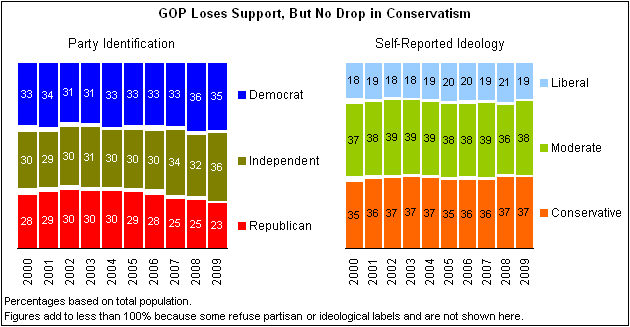
This stability in self-reported ideology is confirmed by a fundamental stability in overall political and social values. Whether by choice or circumstance, Barack Obama is pursuing a fundamentally different path than his predecessor in terms of economic, domestic and foreign policy. Yet there is no commensurate sea-change in public values. In particular, while partisans are more divided, the overall balance of public opinion regarding the proper role of government has shifted only slightly, and there is little evidence of a “populist backlash” against big business or the efficacy of the free market.
The Republican Party has lost ground in the U.S. House of Representatives and U.S. Senate as well as nationwide, and by most accounts the party has lost many of its more moderate representatives, leaving the remaining membership far more conservative on balance. It is not at all clear that the shift in party identification among the general public follows the same pattern, as both conservatives and moderates are leaving the party in roughly equal shares. In 2004, when 30% of Americans called themselves Republicans, 19% identified as conservatives and 11% as moderates or liberals. There are far fewer moderate Republicans today – just 8% of Americans describe themselves this way. But there are far fewer Conservative Republicans as well – 15% down from 19% five years ago.
It appears that most of these ex-Republicans now call themselves political independents, swelling the size of the independent group and shifting its ideological balance toward the right. From 2000 through 2005, roughly 30% of Americans called themselves political independents – about half described themselves as politically moderate, with the remainder divided about evenly between liberal and conservative viewpoints. Today, 36% of Americans call themselves independents, and with more moderates and conservatives in the ranks the ideological balance has shifted. While half continue to describe themselves as moderate, conservative independents now outnumber liberal independents by two-to-one (12% vs. 6%).
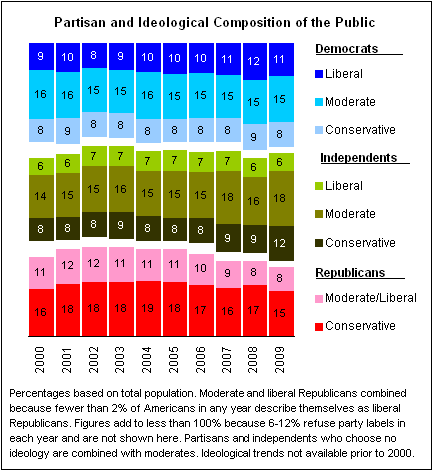
As discussed above, the overall size of the Democratic Party has not changed substantially in recent years. The balance of self-reported ideology within the party has also remained fairly stable. Just under a third of the party’s membership – 11% of Americans overall – describe themselves as liberal Democrats. Another 8% overall call themselves conservative Democrats, and 15% describe themselves as moderate Democrats.
GOP Losing both Conservatives and Moderates
The evidence that the Republican Party has been losing both conservatives and moderates at an equally fast pace is clear. As recently as 2005, more than half (52%) of self-described conservatives identified with the Republican Party. Today, just 41% continue to do so, while the share of conservatives describing themselves as independents has risen from 22% to 32%. The increasing rejection of the GOP by many on the right reaches even into the most conservative Americans. Roughly 7% of Americans describe their ideological outlook as “very conservative”. Four years ago, 59% of these very conservative people identified with the Republican Party. Fewer than half (47%) do so today.
The GOP has lost moderate support as well. The share of self-described moderates who identify with the GOP has fallen from 23% in 2005 to 16% today. The shift, again, is toward being independent – today 43% of moderates identify as independent, up from 36% four years ago. The Democratic Party is making no gains among either moderates or conservatives – the share of both identifying as Democrats is virtually unchanged. But the share of liberals who think of themselves as Democrats has increased sharply from a low of 47% in 2002 to 59% in both 2008 and 2009.

Another way of looking at the relationship between partisanship and ideology is to focus on the balance of ideology within the partisan groups. In other words, rather than asking how many conservatives think of themselves as Republican we can ask how many Republicans think of themselves as conservative. The answer is that the GOP base is a bit more conservative today than it was in 2000, but only marginally so. While the share of Republicans who think of themselves as politically conservative rose steadily from 60% to 68% between 2000 and 2008, it has dipped downward to 65% in 2009 due to the defection of a number of self-described conservatives this year. As such, the GOP is not significantly more conservative today than it was in 2004 or 2005.
Meanwhile, due to the arrival of so many lapsed Republicans, independents are more politically conservative than they have been in a decade. Currently, 33% of independent describe themselves as conservative, up from a low of 26% in 2005.
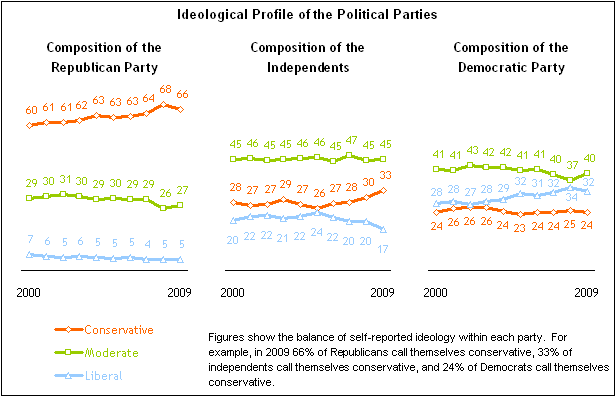
The share of Democrats who describe themselves as politically liberal had increased gradually from 28% in 2000 to a high of 34% in the 2008 election year. But the party has become no more liberal since –32% of Democrats think of themselves as liberal so far in 2009.
Religion and Party Identification
White evangelical Protestants have made up one of the most reliable Republican voting blocs in recent elections, yet even here GOP identification is slipping. Between 2000 and 2004 the GOP had attracted substantial support from non-Hispanic white evangelicals – the share identifying with the party rose from 42% to 50% over this time. But in 2009 the share of white evangelicals identify with the Republican Party has fallen back to 42%. Consistent with the overall pattern elsewhere, Democrats are not attracting support among white evangelicals – an all-time low of just 20% of white evangelicals identify as Democrats. Instead, white evangelicals are increasingly choosing an independent affiliation (33% today up from 23% in 2004).

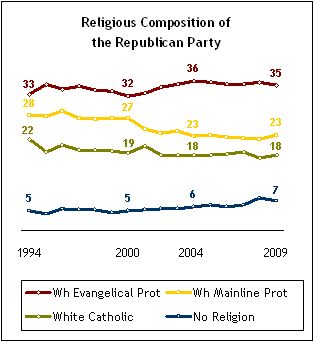
GOP fortunes have slipped slightly among white mainline Protestants and white Catholics as well, with slim pluralities of both groups today describing themselves as politically independent. Democrats have made no substantial gains among any of these large religious groups, though the Americans who have no religious affiliation are increasingly favoring the Democratic Party and avoiding the GOP.
Because Republican Party identification has ebbed across the board, the religious profile of the remaining GOP members is largely unchanged in recent years. Roughly a third (35%) of Republicans are white evangelical Protestants, just under a quarter (23%) are white mainline Protestants, and slightly below a fifth (18%) are white Catholics. None of these figures has changed significantly from 2004.
GOP Continues to Lag in Racial & Ethnic Diversity
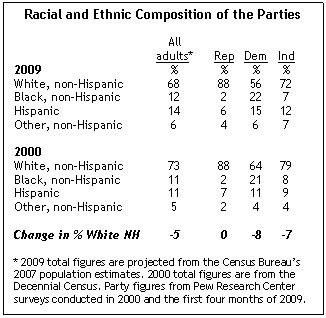
While the American public becomes more racially and ethnically diverse, the Republican Party continues to lag far behind in drawing support from minority groups. According to Census figures, the share of adults who are white, non-Hispanic has fallen from roughly 73% in 2000 to an estimated 68% in 2009, while minorities make up the other 32% of the nation’s adults. Yet few of these minorities are drawn to the Republican Party. In 2009, 88% of Republicans are white, unchanged from 2000 and far above the national total. By comparison, the share of Democrats who are white has fallen from 64% in 2000 to 56% today. The rest of the Democrats are non-Hispanic African Americans (22%), Hispanic (15%) or of another racial minority (6%).
Not surprisingly, the racial and ethnic profile of independents is nearly a cross section of the American adult population – 72% of independents are white and 12% are Hispanic. Just 7% of independents are non-Hispanic African Americans – lower than the national total because Blacks remain overwhelmingly Democratic in party identification.
The Gender Gap
Fewer men and women identify with the Republican Party today than at any point in the past two decades. With this decline, a record proportion of men today consider themselves independents and the share of women who identify as Democrats has also grown to a two-decade high.
Over the past 20 years men have consistently been more likely than women to identify as independents, and independents have made up the plurality among men in every year since 1990. As Republican identification has dropped in recent years, the tendency of men to call themselves independents has increased substantially. Today, just 24% of men call themselves Republicans, down seven points from 31% in 2004 and the lowest in at least two decades. Meanwhile, the share calling themselves independents has spiked upward from 34% to 42% – a record high – with virtually no change in the proportion calling themselves Democrats.

This pattern is even more dramatic when the analysis is limited to white men. The share of white men identifying as Republicans has fallen from 37% in 2004 to just 29% today, with the number of independents increasing by 10 points (from 33% to a new high of 43%). As a result, white men make up no larger a proportion of the GOP base today than in recent years.
The recent trend in partisanship among women is somewhat different. A similar decline in Republican identification (from 28% in 2004 to 22% now) has been met with growth in both the number of independent and Democratic women. The share of women who identify themselves as Democrats has risen to 41%, up 3 points since 2004. This is the largest percentage of women identifying with the Democratic Party in the past two decades. The share of women identifying as independents is also up slightly from 27% in 2004 to 31% today.
These shifts in how men and women identify themselves has meant that the gender gap in GOP identification has virtually disappeared (24% of men, 22% of women), but the 13-point gender gap in Democratic identification (28% of men, 41% of women) is the largest in 20 years.
Republicans Getting Older
For most of the past 20 years Republicans have, on average, been younger than Democrats. This was largely the result of generational patterns of party identification – with the New Deal generation and older Baby Boomers leaning overwhelmingly Democratic and a younger Generation X that came of age during the Reagan administration favoring the GOP. But since 2008 the average Republican is now older than the average Democrat – reflecting the aging of key Republican constituencies and the overwhelming Democratic leaning of the youngest generation of Americans.
As the adult population has aged in recent decades – due to longer lifespans and the aging of the Baby Boom, the average age of both Republicans and independents has increased. But the Democratic Party has evaded the tide due to the substantial influx of younger adults. Overall, the average age of Republicans has increased from 44 in 1990 to 48 in 2009 and the share of Republican 50 and older has increased from 36 to 46 over this same period. Independents are also getting older; the average age has increased from 41 in 1990 to nearly 44 in 2009 and the percent age 50 and older has increased 9 points to 37% today. Meanwhile, the average age of Democrats has remained unchanged (around 47) and the share age 50 and older rose only slightly from 42 to 44 since 1990.

No Regional Dominance
Republican Party identification is at its lowest point in the past 20 years in every region of the country. Since 2004, the GOP has lost at least five points in each major region, while the share identifying as independents has increased by at least five points. Democratic party identification has been relatively stable in most parts of the country, though it has continued to increase gradually in the Northeast.
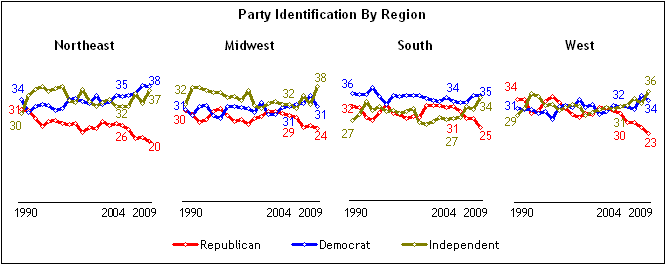
In the Northeast, Democrats now outnumber Republicans by nearly two-to-one; 38% consider themselves Democrats compared with only 20% who identify as Republican. This represents a substantial widening of an already substantial Democratic advantage (35% vs. 26%) in 2004. While the Democrats have held the edge in the Northeast for a number of years, this has not always been the case. As recently as the early 1990s, there was virtually no gap in party identification in this region, and the balance of party identification was no more favorable to the Democrats in the Northeast than in the rest of the country.
Currently, 35% of Southerners consider themselves Democrats, 34% say they are independents and only a quarter (25%) identify with the GOP. This is the largest Democratic advantage in party identification in the South since 1993, though the gap is due to Republican losses not Democratic gains. The share of Republicans in the South is down 6 points from 31% in 2004. These GOP losses are similar even when the analysis is limited to states in the Deep South or limited only to southern whites. Because the losses in the South are comparable to other parts of the country, Republican Party membership is not significantly more tilted to the South today than in the past. Just under four-in-ten (39%) Republicans live in the South in 2009 compared with 38% in 2004.
Party by Income
Party identification is strongly linked to family income levels – people in the highest income households are roughly twice-as-likely as those in the lowest income households to say they are Republicans. But over the past decade, the Republican Party has also lost adherents across all income levels while Democratic identification has remained fairly stable. A greater proportion of people in every income category are identifying as independents.
As recently as 2004 the Republican Party held an 11-point advantage (39% vs. 28% Democrat) in party identification among people in the top 20% income group (with family incomes of roughly $100,000 or more in 2009 dollars). This advantage has virtually disappeared in 2009. Today, 35% of high-income Americans say they are independents while 32% identify with the GOP and 30% with the Democratic Party.
Democrats continue to have a wide advantage among those with incomes in the lowest quintile (under $20,000 in 2009 dollars). In 2009, 42% of lower income Americans consider themselves Democrats – virtually unchanged in recent years – while just 15% are Republicans, down slightly from 19% four years ago. But in the next income level up (those earning between $20,000 and $40,000 in 2009 dollars) the GOP’s decline has been particularly sharp. In 2004, the Democrats held a 13-point edge within this income group (38% vs. 25% Republican). Today, that has opened up to a 24-point lead (40% vs. 16%) as Republican identification has dropped off by 9 points.
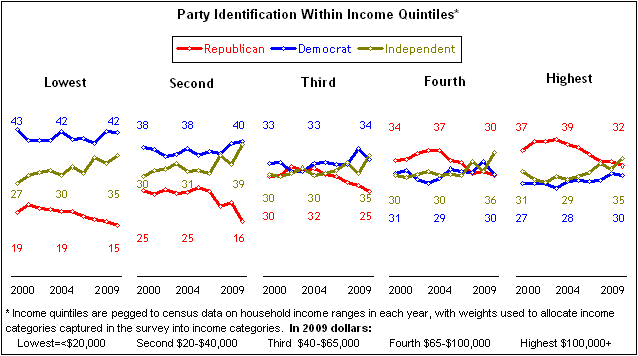
The Republican Party’s Image
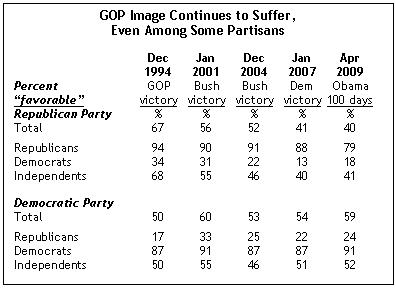
Beyond the Republicans’ losses in partisan affiliation, other measures show that that the GOP has a serious image problem. Favorability ratings of the Republican Party remain far lower than ratings of the Democratic Party, and have fallen off even among Republicans.
The overall public assessment of the Republican Party remains generally negative. By a 51% to 40% margin, more Americans express an unfavorable view of the GOP than a favorable opinion. Not only do three- quarters (75%) of Democrats view the Republican Party unfavorably, but the balance of opinion among independents is also more unfavorable (48%) than favorable (41%).
And even within the shrinking ranks of the GOP itself, fewer have good things to say about the party overall. Typically, both the Democratic and Republican parties receive favorable assessments from roughly nine-in-ten people within their party. Today, 79% of Republicans offer a favorable assessment of the GOP – down from 88% two years ago and 91% in 2004. The share of Republicans who have an unfavorable view of their own party has more than doubled from 8% in January 2007 to 18% today.
Republican frustration with their party is even more apparent when they are asked to rate how the party is doing standing up for traditional Republican issues such as reducing the size of government, cutting taxes and promoting conservative social values. Currently, just 24% of Republicans say the GOP is doing an excellent or good job in this respect, down sharply from 38% last September. As recently as April 2006, 53% of Republicans gave positive ratings to their party.

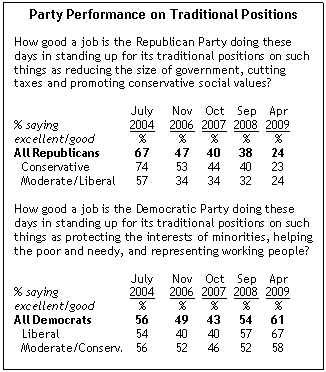
These negative assessments cross ideological lines within the GOP – fewer than a quarter of both conservative Republicans (23%) and moderate and liberal Republicans (24%) give the party positive marks for standing up for its traditional political positions. The decline in satisfaction with the party has been sharpest within the conservative base. In November of 2006 – just following the Democratic Party’s midterm victories – 53% of conservative Republicans gave their party excellent or good ratings, compared with just 34% of moderate and liberal Republicans. Since then, satisfaction has fallen 30 points among conservatives and 10 points among moderates and liberals.
Meanwhile, Democrats offer substantially higher assessments of their party’s performance today than they have in years. Currently, 61% of Democrats say the party is doing an excellent or good job standing up for its traditional positions on such things as protecting the interests of minorities, helping the poor and needy, and representing working people. This is up from 54% last September, and a low of 38% in June 2006. The last time Democrats offered such a positive assessment of their party was when Bill Clinton was still president. In September 2000, 67% of Democrats felt the party was doing well standing up for its traditional positions.
Liberal Democrats offer stronger assessments of the party’s performance than do moderates and conservatives within the party. Two-thirds (67%) of liberal Democrats say they party is doing an excellent or good job standing up for its traditional positions, compared with 58% of moderate and conservative Democrats. This is a reversal from a few years ago. In November 2006, 52% of moderate and conservative Democrats offered a positive assessment of the party compared with just 40% of liberal Democrats.